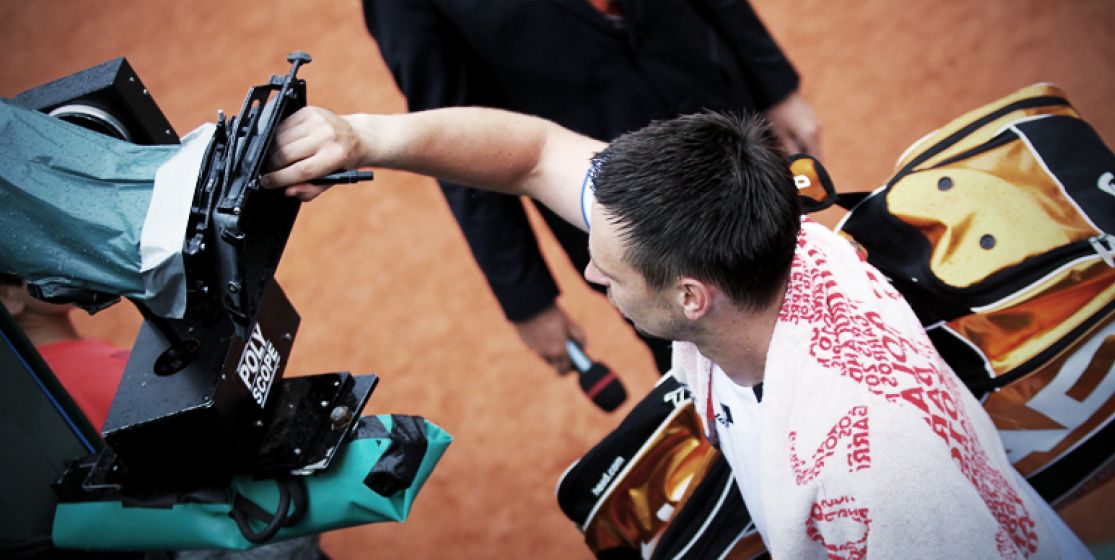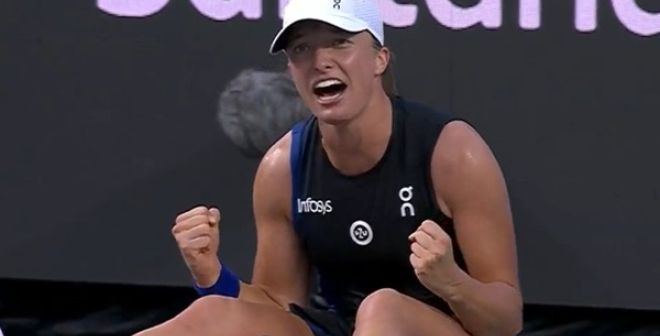Since the early 2000s, tennis players have ritually signed an autograph on the lens of the television cameras at the end of their match. The phenomenon, as futile as it is amusing, was born in France. But who came up with this idea, how and why? We offer a tentative answer...
"F..... But can someone tell me who was the first tennis player to sign on those damned cameras?" On one of the many American forums dedicated to tennis, a user gets upset. His username? PeteSampras. In often foul language, this man has been trying for several years to trace the origin of this strange habit: the autograph signed on the lens of the television cameras upon the exit of court. Internet users, journalists, the simply curious or athletes themselves: on the World Wide Web, many people follow him in this quest for the unknown. And it is an understatement to say that the answers are scarce. “I would say it started 5-6 years ago, not much more. But honestly I'm not sure,” says Nelson Monfort, a famous French journalist for France Télévisions, official broadcaster of Roland Garros. “However I know the reason for it. It is done to mark the end of the international broadcasting signal. This is also the reason why the interviews are conducted after the match. Since until the signature, the broadcast is international, then it becomes local. Symbolically, it is similar to the ending credits of a movie; it shows the end of the match.” Production assistant, and colleague of Nelson, Frederic Tabourin also supports the local label theory. Easy, he's the one who permits this shot to be the broadcast on French screens: “For me, it was tested in France at Bercy in the 90s. At Roland, it was introduced in 2002 or 2003. On the Chatrier court, players sign on the Plexiglas of the camera which is isolated and steady, manipulated at the exit of the court.” Indeed, to hell with the legend, players don't sign with a permanent marker directly at the camera, but on a small plate of polymethylmethacrylate (the scientific name of Plexiglas, which is a trademark) attached to the lens. For each player, they keep the same device, but just change the support. “I arrived in 2002 on the production of Roland Garros as assistant to Fred Godard and at the time it was already being done,” confirms Fred Accorsi. “It is also part of the ritual of the match and is highly anticipated by some fans. We are collared by a lot of people who want the plate when we go in the stands after. After the signature, the channel takes it and then sells it for a charity - especially associations for children - at auction.” At the end of the day, is it not the meaning given to this symbolic ritual: one small gesture for a player, one great leap for mankind?
“Daddy, I want to do it too”
For most of the protagonists on the tour, it isn't really interesting. However, hardly anyone has ever publicly stated his reluctance, annoyance or refusal to do it. So, is the autograph on the camera almost a taboo? “Frankly, why rebel against it,” asked the American journalist Jon Wertheim in Sports Illustrated. “I am very cynical; there is a very fine line between 'tradition' and 'triviality'. I find it ridiculous. And why are the winners the only ones who have the right to sign, huh?” In fact, the rule is unforgiving: there’s always a loser and a winner in tennis, and only the winner has the right to sign. According to Nelson Monfort the reason is quite obvious: “There are players who find it a bit tiring and systematic. I remember some who had forgotten to sign and were pursued by the production assistant who handed them the pen. It happened several times and often the player didn't come back to sign. At the same time, the fact that it's only done after the victory helps to sweeten the pill. It would be much more complicated to sign for the losers.” If athletes don't benefit from it, there are those who think it's funny. The French Michael Llodra, for example, a wine and football lover, turns the mundane administrative task into a little more personal note “He prefers to sign Go Paris', it became a habit for him” recalls Fred Accorsi. Also, since Maria Sharapova opened a Twitter account, she became queen in this area. Last March in Indian Wells, "Tweet Me" was her first camera wink, one that allowed her to gain 3000 followers in a few hours. More rational, she then wondered about the interest of the time change, summer or winter "Who understands?" She scribbled after one victory. Then, a few weeks ago, a paparazzo photographed her with her new boyfriend, the Bulgarian player Grigor Dimitrov “How did you find us?” she wrote at the Madrid tournament, and subsequently justified it at the press conference: “My little notes are thought at the last minute. I was bored with the signatures, and in fact I don't even know why we always have to do it? I mean, the signature is something impersonal, just copy and paste, it's repetitive. So I started to do something different.” Better yet, the phenomenon has found followers among the younger generation. In Canada, Preston Norris, 4 year-old prodigy and star of YouTube, owes his passion for tennis to an autograph from Roger Federer 'on' his television screen “Dad, I want to do that too”, he said one night during a family meal. As fun as it is futile, and that is perhaps its charm, the custom is now reproduced (except in the Davis Cup by BNP Paribas) all around the world: From Canada to Europe via the USA. Whether PeteSampras likes it or not...
By Victor Le Grand and Arthur Jeanne






